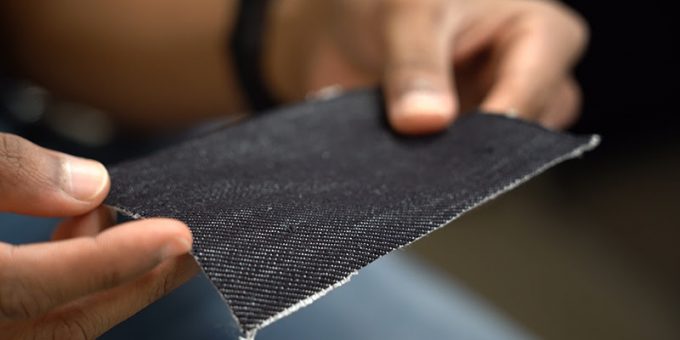
WEST LAFAYETTE – As smartwatches become more powerful, they will generate more heat. To prevent burns or rashes, what if a material touching the skin could feel as cool as metal, but also be flexible enough to be worn on the wrist?
A team of Purdue University engineers has discovered that a type of fabric typically used for hiking gear has remarkable heat-conducting properties on par with stainless steel, potentially leading to wearable electronics that successfully cool both the device and the wearer’s skin.

The material is made of ultra-high molecular weight polyethylene fibers, which are sold commercially under the brand name Dyneema. These polymer-based fabrics are marketed for their high strength, durability, and abrasion resistance, and are often used to create body armor, specialty sports gear, ropes, and nets.
Purdue heat transfer researchers recently investigated other uses for the fabric, namely as a cooling interface between human skin and wearable electronics (see a video about this research on YouTube). Their research is published in Scientific Reports.
“This fabric has great flexibility and thermal properties. If you stitch it differently, weave it differently or start blending the polymers with different materials, you could tailor the fabric’s properties to different applications,” said Justin Weibel, a research associate professor in Purdue’s School of Mechanical Engineering.
If a material has a high thermal conductivity, that means heat dissipates through the material more easily. There are many heat-dissipation methods for fabrics, from the simple (moisture-wicking); to the intricate (conventional fabrics with heat-conducting strands woven in); to the very complex (liquid-cooled garments worn by astronauts).
“Your next smartwatch or virtual reality headset could be more powerful than your current smartphone, so we need to dissipate heat away from the electronic components to keep the wearer comfortable,” said Aaditya Candadai, who recently completed his Ph.D. at Purdue doing research on this project. “These polymer fabrics have amazing thermal properties that can keep these devices cooler and avoid low-degree skin burns.”
The team discovered these properties by benchmarking Dyneema against conventional cotton fabrics, as well as polyethylene sheets in rigid non-woven form. They obtained several different commercially manufactured fabric samples and even wove their own samples from raw Dyneema fibers.
The researchers tested the fabric samples at the Birck Nanotechnology Center in Purdue’s Discovery Park. The samples went into a small vacuum chamber, with a metal wire laid across the surface as a heat source.
Using an infrared microscope, they could generate detailed data about how much heat was being conducted through the fabric’s surface, and in which direction. They found that the Dyneema fabric has 20-30 times higher thermal conductivity than other fabrics, comparable with steel.
The team also tested the fabric’s flexibility, which is important for wearable electronics.
“There’s a balance; we don’t want to make thermally conductive materials that are so stiff, people won’t be comfortable wearing them,” Candadai said. “These polymer fabrics are in that sweet spot of having good conductivity and good flexibility.”
The fabric naturally has these properties with no additional circuity or other equipment, but the researchers also have plans to test how weaving in different materials affects the fabric.
“We could integrate other types of fibers – carbon fibers, metal fibers – to achieve different combinations of properties,” said Amy Marconnet, an associate professor of mechanical engineering.
As part of his work investigating the heat-conducting properties of fabrics, Candadai won an Art-In-Science award in 2019 for an infrared camera image showing how the fabrics transfer heat. The team’s research was performed within Purdue’s Cooling Technologies Research Center, a graduated National Science Foundation Industry/University Cooperative Research Center with support from industry leaders in thermal materials and electronics.
About Discovery Park
Discovery Park is a place where Purdue researchers move beyond traditional boundaries, collaborating across disciplines and with policymakers and business leaders to create solutions for a better world. Grand challenges of global health, global conflict and security, and those that lie at the nexus of sustainable energy, world food supply, water and the environment are the focus of researchers in Discovery Park. The translation of discovery to impact is integrated into the fabric of Discovery Park through entrepreneurship programs and partnerships.
About Purdue University
Purdue University is a top public research institution developing practical solutions to today’s toughest challenges. Ranked the No. 5 Most Innovative University in the United States by U.S. News & World Report, Purdue delivers world-changing research and out-of-this-world discovery. Committed to hands-on and online, real-world learning, Purdue offers a transformative education to all. Committed to affordability and accessibility, Purdue has frozen tuition and most fees at 2012-13 levels, enabling more students than ever to graduate debt-free. See how Purdue never stops in the persistent pursuit of the next giant leap at https://purdue.edu/.
Information provided by Jared PikeSources: Justin Weibel, jaweibel@purdue.edu



